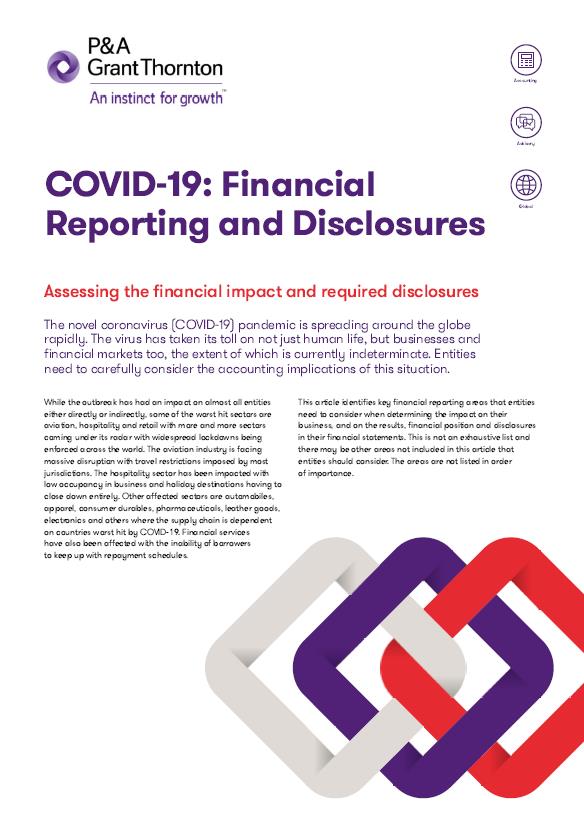This accounting alert is issued to provide detailed consideration of assessing the financial impact and required disclosures in relation to COVID-19.
Introduction
As the spread of the novel coronavirus (COVID-19) pandemic goes global, it has taken its toll on not just human life, but businesses and financial markets too. Some of the worst hit sectors are aviation, hospitality and retail, with more and more sectors coming under its radar with widespread lockdowns being enforced across the world. Entities need to carefully consider the accounting implications of this situation. This article identifies key financial reporting areas that entities need to consider when determining the impact on their business, and on the results, financial position and disclosures in their financial statements. This is not an exhaustive list and there may be other areas not included in this article that entities should consider.
Disclosures
The article lists down disclosures that need to be made in the financial statements, which include those that affect the following:
- Impairment
- Goodwill
- Financial instruments and the measurement of expected credit losses
- New employee benefits and termination benefits
- Measuring defined benefit obligations
- Other areas (e.g., revenue, inventory, hedge accounting, debt repayment and classification, derecognition of debt and other liabilities, among others)
The article also cites examples on how these areas could possibly be affected by the current situation, which serves as a guide for entities assessing the financial impact of the outbreak, whether directly or indirectly.
Subsequent Events
If the widespread impact of COVID-19 began during the entity's reporting period, the impact will be reflected in its financial statements for that period. However, to the extent that the widespread impact of the outbreak occurred during the period between the end of the reporting period and the date when the financial statements are authorized for issue, management must determine how the developments subsequent to year-end should be reflected in the entity's financial statements for the period under audit or review.
The article lists down examples of non-adjusting events that would generally result in disclosure, as well as several example disclosures for these events. Since COVID-19 is likely to have an impact also to financial statements for reporting periods ending after December 31, 2019, the article also provides guidance on considerations that need to be made in using judgment to determine the impact of COVID-19.
Going Concern
IAS 1, Presentation of Financial Statements, explicitly states that at each reporting date, management is required to assess the entity’s ability to continue as a going concern and consider all available information about the future, which is at least, but is not limited to, twelve months from the annual reporting date. Management should consider a wide range of factors, such as: current and expected profitability, debt repayment schedules and potential sources of replacement financing and the ability to continue providing services.
Because the assessment regarding an entity’s ability to continue as a going concern covers the period no less than twelve months from the annual reporting date, all events that occur during an entity’s subsequent events period should be considered when evaluating whether there is significant doubt about the entity’s ability to continue as a going concern. In other words, even if events during the subsequent events period are not considered adjusting subsequent events, they should still be incorporated into the going concern assessment.
If management concludes that the entity may be liquidated (either by choice or because it has no realistic alternative but to do so), the going concern assumption would not be appropriate and the financial statements may have to be prepared on another basis, such as a liquidation basis. If there is material uncertainty about the entity’s ability to continue as a going concern, the entity should include going concern disclosure in the notes to its financial statements.
The article provides sample disclosures for an entity that concludes that there is significant doubt about its ability to continue as a going concern.
See attached article for the complete details of this publication.

